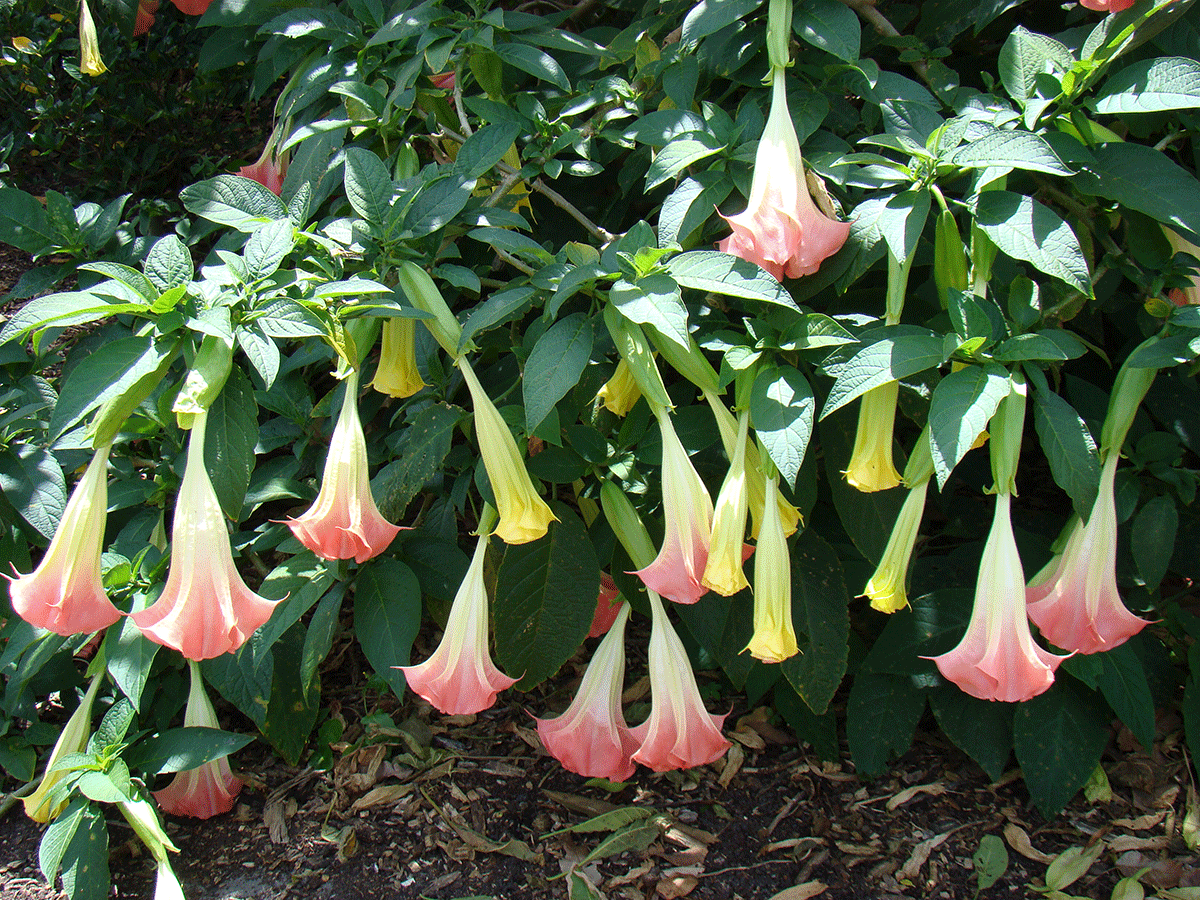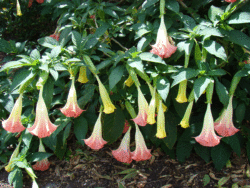Disturbance in Your Mind
High Among the Angels
Brugmansia aren’t your garden-variety gateway drug
Published: March 1, 2019
Last Updated: May 31, 2019

Photo by Asit K. Ghosh
Brugmansia suaveolens in gorgeously sinister full bloom.
Popular tropical plant playing poisonous Pied Piper to teens,” announced the Times-Picayune on an October Sunday in 1994. “A sweet-smelling plant with a heavenly name is gaining a devil of a reputation as this year’s cheap way to a quick high.” The Metro section report was whimsical in its language, with that rather wonderfully alliterative run of plosives in the headline and compounded puns in the lede to boot—but the subject was no joke.
The Louisiana Poison Control Center had gotten multiple reports about teenagers landing in the hospital, staff writer Lynne Jensen wrote, after ingesting tea home-brewed from angel’s trumpet, the popular tropical plant in question. “He was a perfect kid up until six months ago,” the parent of one poisoned sixteen-year-old told Jensen. “Then he decided he didn’t want to be a nerd anymore.”
The plant colloquially known as angel’s trumpet is a flowering shrub of the genus Brugmansia, which itself comprises seven different species, all toxic and all officially designated as Extinct in the Wild on the International Union for Conservation of Nature’s “red list” of threatened species. Native to South America, it’s popular as an ornamental plant in parts of the world with mild, semi-tropical climates like New Orleans—where, according to Louisiana State University AgCenter horticulturalist Anna Timmerman, it’s been cultivated since the middle of the nineteenth century.
“It’s relatively easy to grow and propagate, so people have been enjoying it in their gardens for a long time. It’s really beautiful when the flowers are out,” she wrote in an email. Like the genus Datura, she explained, it is a member of the family Solanaceae; the difference is that Brugmansia has a woody trunk and branches, with flowers that dangle like bells, as opposed to Datura’s upright blossoms and softer, herbaceous stems.
Datura and other members of Solanaceae, the gothically monikered nightshade family, are much more infamous than the bright and fragrant Brugmansia. Belladonna, mandrake, and henbane, solanaceous plants containing dangerous psychoactive alkaloids like those found in the angel’s trumpet, turn up poetically all over Western literature, from Shakespeare to witches’ spellbooks. The US Forest Service website includes a page titled “The Powerful Solanaceae” that features a sixteenth-century anti-witchcraft text detailing the medieval sorcerer’s practice of inhaling the smoke from burnt henbane or mixing belladonna, thorn apple, and henbane with fats and oils to make a “witches’ ointment” that could be applied topically. The idea was to experience the hallucinogenic effect of those alkaloids, with less fear of fatal poisoning. (The US Forest Service does not recommend such experimentation, nor does it or any other federal regulatory body endorse ingesting toxic Solanaceae in any manner. Do not do it.)
The intense psychoactive compounds derived from Brugmansia do have medical uses: hyoscine, also known as scopolamine, which is now usually synthesized artificially, is used to treat nausea and to stem saliva production. It’s also a key plot point to an enduring urban myth that the Guardian investigated as recently as 2015. Criminals, the story goes, contrive to blow a cloud of scopolamine powder in the face of an unsuspecting prospective mark, or get them to touch a business card soaked in the substance. The victim becomes drowsy and completely pliable, and later remembers nothing. (Pharmacology professor Val Curran, interviewed in the Guardian, agreed that scopolamine has amnesiac effects and causes drowsiness. “It would completely zonk you out,” Curran said, leaving you with a blurry recollection similar to the aftermath of heavy drinking or benzodiazepine use. “But I don’t know about removing free will.”)
As widely documented—both by amateur psychedelic chemists on drug-focused message boards and by doctors and law enforcement who’ve been confronted with experimenters—ingesting angel’s trumpets has significantly more dramatic effects. The classic mnemonic for identifying Datura or Brugmansia poisoning goes “hot as a hare, blind as a bat, dry as a bone, red as a beet, mad as a hatter,” ticking off symptoms that include hallucinations (mad), spiking body temperature accompanied by decreased sweat and saliva production (dry and hot), tachycardia and difficulty breathing (red), and even temporary blindness (blind).
The nature of the hallucinations caused by Brugmansia sound particularly unpleasant. Admittedly, some of the reports via official channels seem reminiscent of LSD panic, with specific and unlikely-sounding visions (one 2004 editorial in the Crowley Post claimed a teen under the influence of Brugmansia tea attempted to eat his own arm, thinking it was a roast beef sandwich; another victim believed he was being threatened by “hostile cherries”). But even when you enter the domain of drug enthusiasts, the warnings are dire: “Not enjoyable would be a huge understatement,” posted one member of a message board for fans of psychedelics. “If you’re lucky you’ll be stuck in a horrifying disassociative/hallucinogenic trip in which you can’t tell reality from hallucination and that lasts for hours or days,” added another. “If you aren’t lucky, you’ll end up dead.”
Despite its universal bad reviews, reports of angel’s trumpet poisonings in Louisiana (as well as Florida and Southern California, where in early 2010, according to the Los Angeles Times, a beat cop went door-knocking at homes where he saw the plant growing to inform residents of its dangers) still seem to turn up with regularity. In 2004, the Times-Picayune reported, the New Orleans City Council passed a law banning the “manufacture or sale of compounds made from the plant.” The following year, the state legislature outlawed the cultivation of nearly forty hallucinogenic plants, including psilocybin mushrooms and belladonna—and Brugmansia—for any use beyond decoration. (This was amended a couple of times since then, most recently in 2015, to add more dangerous species to the list, as well as more specific language that freed up plants used in federally approved homeopathic drugs.)
Moral of the story: Leave the trumpets at the second line. (Or in the garden.)
Alison Fensterstock has written about American arts and culture for NPR, Pitchfork, Rolling Stone, the New York Times, and others. She has served as the music critic for both Gambit and the Times-Picayune in New Orleans.
